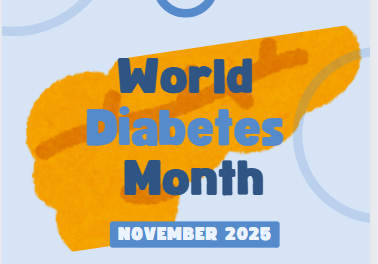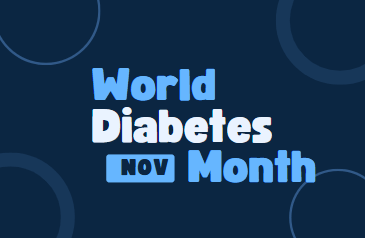Diabetes Awareness Month: Understanding, Supporting, and Taking Action This November
Meta Description: November is Diabetes Awareness Month! Learn about diabetes, its impact, and how you can get involved to support those affected and promote healthier communities.
The Blue Circle: Why Diabetes Awareness Matters Now More Than Ever
Did you know that millions of Americans are living with diabetes, and many more are unaware they even have it? Diabetes, a chronic condition that affects how your body turns food into energy, has a profound impact on individuals, families, and our communities. Maybe you or someone you know is navigating the daily challenges of managing blood sugar, worrying about potential complications, or feeling overwhelmed by the information out there.
This November, during Diabetes Awareness Month, we have a powerful opportunity to come together. To learn more about this widespread condition, to show our support for those living with diabetes, and to take meaningful action towards prevention and better management.
This post will explore the importance of diabetes awareness, delve into ways you can get involved, and provide you with valuable resources to make a difference. Our aim is to empower you with knowledge, connect you with resources, and inspire you to be a part of the solution, transforming your understanding of diabetes and motivating you to take positive steps.

Table of Contents
Understanding the Scope of Diabetes
Diabetes occurs when the body doesn’t make enough insulin or can’t effectively use the insulin it makes. Insulin is a hormone that helps glucose (sugar) from food get into your cells to be used for energy. Over time, high blood sugar levels can lead to serious health problems, including heart disease, kidney disease, nerve damage, and vision loss.
There are several types of diabetes, with the most common being:
- Type 1 Diabetes: An autoimmune disease in which the body’s immune system attacks and destroys the insulin-producing cells in the pancreas. People with type 1 diabetes need to take insulin every day to survive.
- Type 2 Diabetes: The body doesn’t make enough insulin or doesn’t use insulin well. It often develops in adults but can occur at any age. Lifestyle factors play a significant role in its development.
- Gestational Diabetes: Develops in some women during pregnancy and usually goes away after the baby is born. However, it increases the risk of developing type 2 diabetes later in life for both the mother and the baby.
Pain Points & Concerns for Individuals Affected by Diabetes:
- Constant Monitoring and Management: The daily burden of checking blood sugar, administering medication (insulin or oral medications), and making careful food choices can be physically and emotionally exhausting.
- Fear of Complications: The potential for long-term health complications can create anxiety and fear.
- Feeling Isolated and Misunderstood: Others may not fully grasp the daily challenges and lifestyle adjustments required to manage diabetes.
- Information Overload and Conflicting Advice: Navigating the vast amount of information about diabetes can be overwhelming and confusing.
Goals & Aspirations for Individuals Affected by Diabetes:
- Achieving Good Blood Sugar Control: Maintaining stable blood glucose levels to prevent complications and live a healthy life.
- Living an Active and Fulfilling Life: Not letting diabetes limit their ability to pursue their passions and enjoy life.
- Finding Support and Connection: Connecting with others who understand their experiences.
- Accessing Quality Care and Resources: Having access to the education, tools, and medical support needed to manage their condition effectively.
Desired Transformation for Individuals Affected by Diabetes:
Through increased awareness and support, individuals with diabetes can feel more empowered, less isolated, and better equipped to manage their condition and live full, healthy lives.

How You Can Get Involved This Diabetes Awareness Month
Diabetes Awareness Month is a call to action for everyone. Whether you are living with diabetes, have a loved one who is, or simply want to contribute to a healthier community, there are many ways to get involved:
1. Educate Yourself and Others:
- Learn the Basics: Understand the different types of diabetes, their risk factors, symptoms, and potential complications. Reputable sources like the American Diabetes Association (ADA) and the Centers for Disease Control and Prevention (CDC) offer a wealth of information.
- Share Information: Use your social media platforms to share facts, infographics, and personal stories (with permission) about diabetes. Use relevant hashtags like #DiabetesAwarenessMonth and #WorldDiabetesDay (November 14th).
- Talk to Your Family and Friends: Start conversations about diabetes and its impact. Correct any misconceptions you might hear.
2. Support Local Events and Initiatives:
- JDRF One Walk: Participate in or donate to a JDRF One Walk in your area to raise funds for type 1 diabetes research.
- ADA Step Out: Walk to Stop Diabetes: Join or support the ADA’s fundraising walk to support people affected by diabetes.
- Local Health Fairs and Screenings: Check if there are any diabetes awareness events, health fairs offering blood sugar screenings, or educational seminars happening in your community. Volunteer or attend these events.
3. Show Your Support Online:
- Wear Blue on World Diabetes Day (November 14th): The color blue is the global symbol for diabetes awareness. Wear blue to show your solidarity.
- Engage with Online Campaigns: Follow the ADA, JDRF, and other diabetes organizations on social media. Share their posts, participate in online discussions, and use their awareness filters or frames.
- Share Personal Stories (If Comfortable): If you are comfortable, consider sharing your own experiences with diabetes to help others feel less alone and to educate the public.
4. Advocate for Change:
- Contact Your Representatives: Support policies that improve access to affordable diabetes care, medication, and education.
- Support Research Organizations: Donate to organizations dedicated to funding diabetes research.
5. Make Healthy Choices:
- Focus on Prevention: Encourage healthy lifestyles that can help prevent or delay the onset of type 2 diabetes, such as regular physical activity, a balanced diet, and maintaining a healthy weight.
- Get Screened: If you have risk factors for type 2 diabetes, talk to your doctor about getting screened. Early detection is key to managing the condition effectively.

Together, We Can Make a Difference
Diabetes Awareness Month is a reminder that we all have a role to play in addressing this significant health challenge. By increasing our understanding, supporting those affected, and taking action in our communities, we can help create a world where diabetes is better understood, managed, and ultimately, prevented. Let’s use this November to shine a light on diabetes and work towards a healthier future for everyone.
Concluding FAQ
Q1: What are the main risk factors for type 2 diabetes?
A: Key risk factors include being overweight or obese, having a family history of type 2 diabetes, being physically inactive, being 45 years or older, having had gestational diabetes, and belonging to certain racial and ethnic groups.
Q2: What are some common symptoms of diabetes?
A: Common symptoms can include frequent urination, excessive thirst, unexplained weight loss, increased hunger, blurred vision, slow-healing sores, and frequent infections. However, many people with type 2 diabetes may not have noticeable symptoms, especially in the early stages, which highlights the importance of screening.
Q3: How can I support a friend or family member who has diabetes?
A: Educate yourself about their condition. Be understanding and supportive of their dietary needs and management routines. Offer practical help, like going for walks with them or helping with meal preparation (following their guidelines). Most importantly, listen to them and let them know you care.
Q4: Where can I find reliable information and support resources for diabetes?
A: Reputable organizations include the American Diabetes Association (https://www.diabetes.org/), the Centers for Disease Control and Prevention (https://www.cdc.gov/diabetes/), and the Juvenile Diabetes Research Foundation (https://www.jdrf.org/). These websites offer comprehensive information, resources, and support programs.
References
American Diabetes Association. (n.d.). About Us. Retrieved from https://www.diabetes.org/about-us
Centers for Disease Control and Prevention. (n.d.). Diabetes. Retrieved from https://www.cdc.gov/diabetes/index.html
Juvenile Diabetes Research Foundation. (n.d.). Our Mission. Retrieved from https://www.jdrf.org/impact/our-mission/
National Institute of Diabetes and Digestive and Kidney Diseases. (n.d.). What is Diabetes? Retrieved from https://www.niddk.nih.gov/health-information/diabetes/overview/what-is-diabetes
World Health Organization. (n.d.). Diabetes. Retrieved from https://www.who.int/news-room/fact-sheets/detail/diabetes